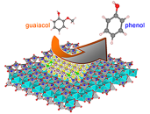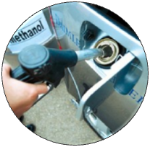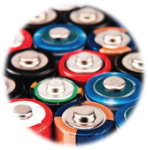____________________________________
Industrial Liaison Group:
Tel: +44 (0) 1235 778797
E-mail: [email protected]
 One of the most significant challenges facing modern society is to balance the growing demand for power with the dwindling supply of fossil fuels. Meeting this challenge will require more efficient use of existing resources, improving the cost and energy efficiency of existing processes, developing new processes and technologies, and exploring alternative sources of power.
One of the most significant challenges facing modern society is to balance the growing demand for power with the dwindling supply of fossil fuels. Meeting this challenge will require more efficient use of existing resources, improving the cost and energy efficiency of existing processes, developing new processes and technologies, and exploring alternative sources of power.
Scientists researching future energy solutions use Diamond’s facilities to develop and refine new energy technologies. Below are some examples.

With 27% of global energy consumption occurring in the residential sector, harvesting and storing thermal energy is increasingly important.
A promising technology is based on phase-change materials (PCMs) that absorb or release large amounts of heat when they change state, e.g. from solid to liquid.
PCMs incorporated into building materials could remove excess heat during the day and release it at night, with minimum carbon emissions. One approach in stabilising PCMs for use is nanoscale confinement in core-shell structures.

Indonesia is one of the largest suppliers of palm oil in the world, producing 42 million tonnes in 20181. It is also experiencing an increase in car usage, coupled with a growth in imports of fuel.
To overcome this problem, the Indonesian government is driving a move to biofuels. Until recently the fresh fruit bunch from palm oil has successfully been used, however the empty fruit bunch (EFB) and palm kernel shell (PKS) provide a more sustainable source of lignocellulose, a key component in second generation biofuel production.
One prospective method for the biofuel production is conversion of lignocellulose into bio-oil via fast pyrolysis and then upgrading the bio-oil over a catalyst, to remove oxygen. However, the existing alumina-based and noble metal catalysts still suffer from catalyst deactivation due to carbon deposition and metal leaching.

Over recent years we have seen a global move towards renewable energy not only to support increased demand for energy but also to reduce the production of carbon dioxide, a common pollutant from burning fossil fuels. Engineers and scientists are continually looking at ways to store this energy during periods of low user consumption (day-time) and to maximise its usage during periods of high demand (evening-time).
Read more....jpg)
In today’s battle against climate change, replacement of conventional cars with battery electric vehicles (BEV) offers an opportunity to significantly reduce future carbon dioxide emissions. Currently, BEVs employ lithium-ion batteries which are expensive to produce and have significant drawbacks; their safety and limited transport being the main issues. Significant interest is therefore being shown in replacing these lithium-ion batteries with a lithium-sulfur battery (LiS or Li2S/Si), which operates using a cheap and abundant raw material with about a two-fold higher specific energy compared to lithium-ion batteries.
Read more...
Management and disposal of higher activity radioactive wastes is a significant issue across the developed world as many countries with a history of nuclear power generation and military activities seek long term solutions for these materials. The most common disposal choice is containment within a deep geological disposal facility (GDF). To remain effective over the long term, the design of a GDF must limit the mobility and migration of radionuclides.
Read more...
Liquid crystal displays (LCDs) are currently very inefficient in terms of energy use. An electric field governs the direction of the liquid crystal molecules (which switches each pixel on or off) but currently a combination of polarisation filters and colour filters are used to view each pixel and provide colour. Each of these filters also block some of the light. The result is that only approximately 9% of the backlight is emitted from the display itself so is important to find alternative ways of controlling pixels and colour in LCD displays to reduce cost and energy consumption.
Read more...
Water injection in a well known method used to increase oil recovery. Until around 2000, mechanisms behind this were believed to be physical (maintaining reservoir pressure) in nature. Through the development of BP’s LoSal® (reduced salinity) enhanced oil recovery (EOR) technology, modification of the brine chemistry of the injection fluid has been shown to play an important role in oil recovery performance.
Read more...
Catalytic production of methanol is an industrially important process and this high-energy density liquid is widely used in the manufacture of plastics and synthetic fibres, and in fuel cells. Currently, methanol is synthesized on a large scale using natural gas from an energy-inefficient process, which requires an endothermic, and therefore thermally intensive, step to completely break down the methane to CO/H2 before methanol can be formed. Scientists from the University of Oxford were keen to explore an alternative non-syn-gas route for methanol production utilising ethylene glycol (EG) which can be sourced from biomass.
Read more...
Diminishing supplies of fossil fuels, together with the desire to reduce greenhouse gas emissions, has propelled electrochemical storage to the forefront of modern research. In particular, Li-ion batteries have empowered consumer electronic devices and are now seen as having great potential for use in (hybrid)-electricvehicles, where high power densities are essential. In the search for new positive electrodes to meet this demand, there has been a focus on polyanionic compounds and how they can be manipulated to control the voltage of the transition metal redox couple.
Read more...
Using current technologies, it is possible to store and transport hydrogen as a liquid at very low temperatures, or a gas under very high pressure, but both of these have serious implications for weight, cost and safety. Metal-organic frameworks (MOFs) are extended molecular structures constructed from metal cations linked by organic molecules. They have recently shown considerable promise in a wide range of applications, including hydrogen storage, catalysis and drug delivery.
Read more...
In theory, sufficient energy reaches the earth’s surface from the sun to meet all of our foreseeable energy needs in a sustainable manner. In practice, the best currently available technology for converting solar energy into electricity – the silicon photovoltaic cell - is very expensive and intrinsically difficult to manufacture on a large scale. Organic based photovoltaics (OPV) that can be manufactured using environmentally friendly materials in low temperature, low cost continuous processes could make a significant contribution to total energy demands.
Read more...Diamond Light Source is the UK's national synchrotron science facility, located at the Harwell Science and Innovation Campus in Oxfordshire.
Copyright © 2022 Diamond Light Source
Diamond Light Source Ltd
Diamond House
Harwell Science & Innovation Campus
Didcot
Oxfordshire
OX11 0DE
Diamond Light Source® and the Diamond logo are registered trademarks of Diamond Light Source Ltd
Registered in England and Wales at Diamond House, Harwell Science and Innovation Campus, Didcot, Oxfordshire, OX11 0DE, United Kingdom. Company number: 4375679. VAT number: 287 461 957. Economic Operators Registration and Identification (EORI) number: GB287461957003.